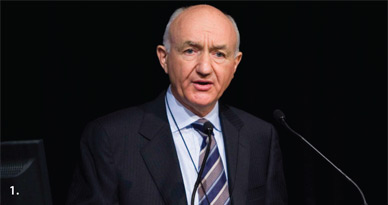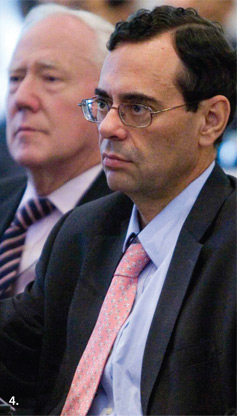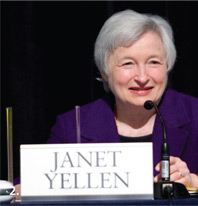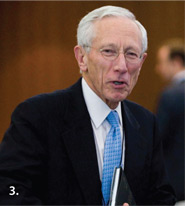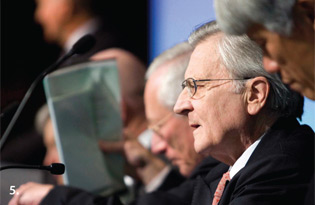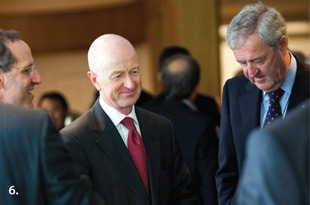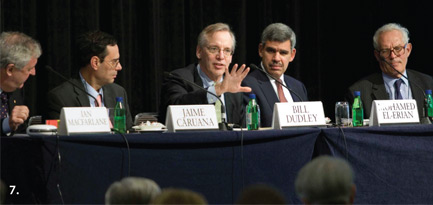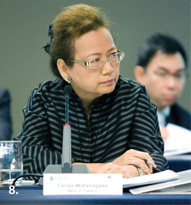Reserve Bank of Australia Annual Report – 2010 Accountability and Communication
Relationship with Government
Section 11 of the Reserve Bank Act 1959 sets out the relationship between the Government and the Reserve Bank Board. It confers substantial independence on the Board, but balances this with an obligation to inform the Government of its policies ‘from time to time’ and a requirement for Parliamentary accountability. Regular discussions between the Governor and the Treasurer serve to keep the Government informed.
Reporting Obligations
For the purposes of the Commonwealth Authorities and Companies Act 1997 (CAC Act), the Reserve Bank is a Commonwealth authority and the members of the Reserve Bank Board are the directors of the Reserve Bank. The directors are responsible for the preparation of the annual report. At its meeting on 3 August 2010, the Board resolved that the Chairman sign the annual report and financial statements as at 30 June 2010, and give them to the Treasurer for presentation to the Parliament, in accordance with the CAC Act.
The House of Representatives Standing Committee on Economics has, in its Standing Orders, an obligation to review the annual report of the Reserve Bank and the annual report of the Payments System Board. The Committee holds twice-yearly hearings, at which the Bank presents its views on the economy and responds publicly to questions from Committee members. In 2009/10, the Governor and senior officers attended hearings in Sydney in August 2009 and in Canberra in February 2010. These appearances, and the quarterly Statement on Monetary Policy (see below), are important elements of the arrangements embodied in the understandings between the Governor and the Treasurer (outlined in the fourth Statement on the Conduct of Monetary Policy, which was issued in December 2007).
During the year, senior staff of the Reserve Bank provided evidence before an inquiry by the Senate Economics References Committee into access to finance by small businesses, to which the Bank had made a written submission. A submission by the Bank was also made to an inquiry by the same committee into the bank funding guarantees.
Communication
The Reserve Bank seeks to ensure a high degree of transparency about its goals, decision-making processes and the reasons for its policy decisions. Transparency facilitates the accountability of an independent central bank in a democracy. Importantly, it also increases the effectiveness of policy decisions by promoting more informed decision-making by the community.
The Reserve Bank publishes its Statement on Monetary Policy each quarter to inform the financial markets, media and wider community about the Bank's thinking on monetary policy and provide a basis for the Parliamentary Committee's questioning of the Bank. These statements provide an analysis of the state of the economy and financial markets, the outlook for inflation and economic growth, and further explanation of recent decisions on interest rates. The Governor also issues a statement immediately after each meeting of the Reserve Bank Board, announcing and explaining the Board's monetary policy decision, and minutes of each meeting are issued two weeks later providing background to the Board's deliberations.
The Financial Stability Review, published in March and September each year, gives a detailed assessment of the overall condition of Australia's financial system. It also contains analysis and views on issues of specific interest; in the past year such issues included wholesale funding, global recovery rates on corporate defaults, and foreign currency exposure and hedging.
In addition to these regular communications, the senior management of the Reserve Bank also give frequent speeches. During 2009/10, the Governor, Deputy Governor and senior officers gave 36 on-the-record speeches on various topics. Audio files of these speeches, including the associated ‘question and answer’ sessions, were made available on the Bank's website, further enhancing transparency and accountability.
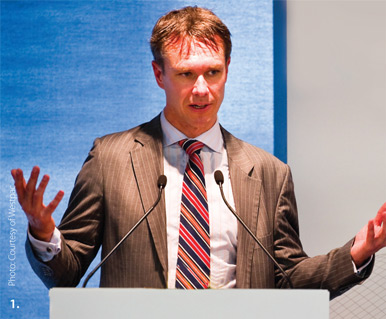
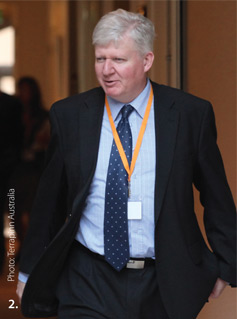
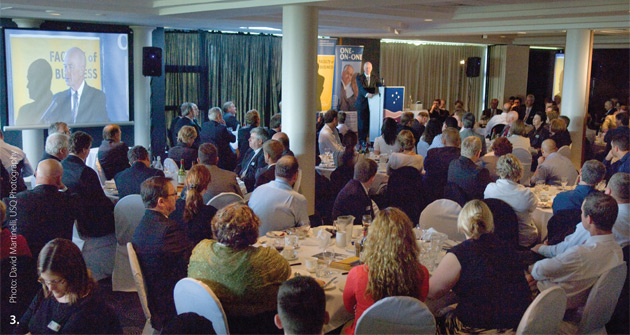
The Reserve Bank Bulletin contains articles about economic and financial developments, along with major speeches. Until December 2009 it was published monthly and also included statistics, media releases and minutes of the monetary policy meetings of the Board; it became a quarterly publication in March 2010 with a greater focus on the analytical work of the Bank. Statistics have since been published only on the website, updated in near real time and with additional data series made available to the public. Articles in the Bulletin over the past year have covered numerous topics, including bank fees and margins, ATM reform, deposit guarantee arrangements, developments in commercial and residential property, price-setting behaviour, the labour market and demographic trends.
The Reserve Bank disseminates research conducted by the staff in the form of Research Discussion Papers (RDPs). While the views expressed in these papers are those of the authors and do not necessarily represent those of the Bank, their publication encourages discussion and comment on economic issues among a broad range of researchers. During 2009/10, 10 RDPs were released on a wide range of topics, such as economic modelling and forecasting (including of inflation), the macroeconomic consequences of volatility in relative prices and capital flows, the transmission of shocks internationally in the presence of leverage constraints, and papers using household-level data related to consumption and labour market status. Staff have had their work accepted for publication in various jounals, such as the Australian Economic Review, Economic Analysis and Policy, Economic Papers, the Economic Record, the Journal of the History of Economic Thought, the Journal of Economic Dynamics and Control and the North American Journal of Economics and Finance.
Reserve Bank staff frequently present their research at external conferences. In 2009/10, papers were presented at such gatherings as the Bank of Israel's Macroeconomic Modelling Workshop, held in Jerusalem; the Workshop of the Asian Research Network on Monetary Policy and Exchange Rates, held in Tokyo; a workshop jointly sponsored by the Bank of England and the European Central Bank on Central Counterparty Risk Controls, held in Frankfurt; a meeting of the Society for Computational Economics, in Sydney; the 21st Annual East Asia Seminar on Economics, also in Sydney; a gathering of the Econometrics Society, in Canberra; and the Chinese Economists Society Annual Conference, in Xiamen.
The Reserve Bank hosts regular conferences, bringing together academics, central bankers and other economics practitioners. In early 2010, the Bank held a symposium to mark its 50th anniversary. The Symposium provided a forum to discuss what policymakers have learned over recent decades and what needed to be reconsidered in the areas of monetary and regulatory policies, as well as supply-side policies. It was attended by a large number of distinguished guests, including heads of various central banks and prominent academics. A volume containing the Symposium papers and discussions was published in July 2010. The Bank has issued a call for papers for a Research Workshop to be held later in 2010 focusing on issues relating to the growing importance of China and east Asia in the global economy. This follows a Research Workshop at the end of 2009 on monetary policy in open economies, which was organised in conjunction with the Bank for International Settlements and featured nine papers by academics and central bankers from Australia and overseas. The Bank was also host to a number of prominent academics through the year, who presented seminars during their visits and conducted research on issues relevant to monetary policy, with one paper being released as part of the Bank's RDP series.
The Reserve Bank publishes information in both electronic and hardcopy formats. Demand for hardcopy publications has been declining as use of the Bank's website continues to grow strongly. In keeping with the public's expectation for effective online access to information, the Bank's website was rebuilt and launched in December 2009, with improved functionality and search tools. In 2009/10, the number of page views/downloads of information on the website averaged about 90,000 per day, though there were nearly 300,000 on some days when interest rate decisions were announced.
